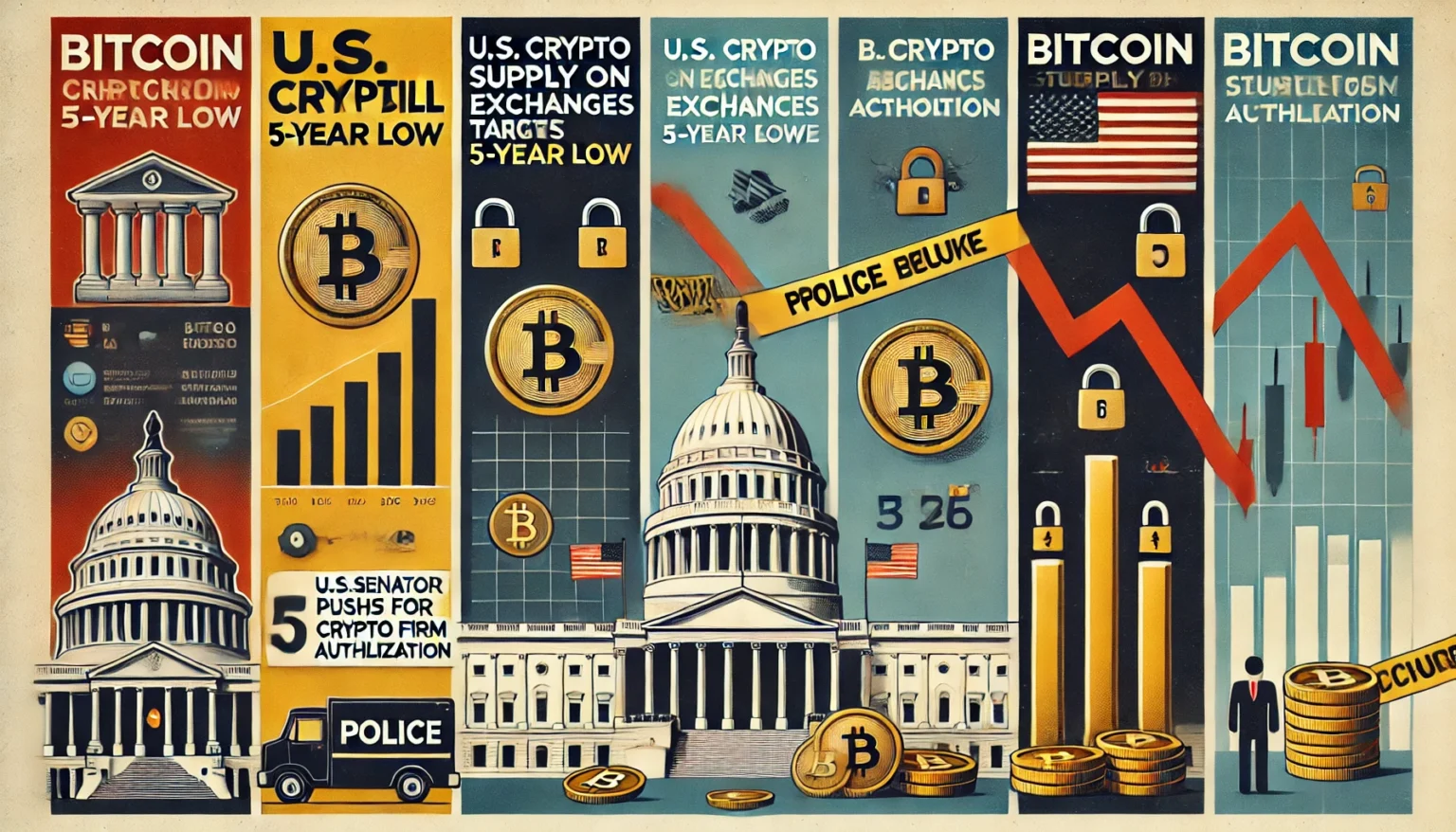A pivotal day in the crypto space as U.S. lawmakers accelerate efforts around both combating illicit activity and exploring Bitcoin as a sovereign reserve asset. Technical signals warn of a possible downturn even as investor behavior turns bullish, pulling Bitcoin off exchanges in record volumes. Meanwhile, the UK makes long-term regulatory commitments, signaling growing international focus on crypto frameworks. Altogether, today’s developments highlight the battle between regulatory control, national strategy, investor sentiment, and market signals.
U.S. Crypto Bill Targets Illicit Finance With Renewed Bipartisan Support
The reintroduction of the Financial Technology Protection Act (FTPA) marks a pivotal move by U.S. lawmakers aiming to curb illicit financial activity facilitated by digital assets. Spearheaded by Representatives Zach Nunn and Jim Himes, the bill proposes the formation of an interagency working group combining government expertise from entities like the DOJ and FBI with insights from crypto industry professionals. The act is positioned as a forward-looking policy tool, emphasizing national security without stifling innovation.
The core purpose of the FTPA is to improve oversight of suspicious blockchain activities while simultaneously enhancing the capacity of law enforcement and intelligence agencies to tackle crypto-related crime. The collaborative structure of the working group allows for a multifaceted approach, balancing enforcement with education and technological adaptation. Importantly, the bipartisan nature of this push underscores the increasing political will to provide a regulatory backbone to the fast-evolving digital asset space.
While the act primarily focuses on deterring terrorism financing and criminal transactions, it may also open doors for more defined guidelines in the crypto industry. By involving crypto experts, the bill avoids the traditional heavy-handedness often seen in early-stage regulation and paves the way for practical, implementable rules. Overall, the FTPA may become a model framework for future global initiatives aimed at harmonizing security and innovation.
Market Impact:
This legislative move could create short-term uncertainty, particularly for privacy-focused coins, but it’s largely neutral to positive in the medium term. The inclusion of crypto experts and the collaborative nature of the bill suggest a balanced approach that could boost investor confidence in regulated markets.
Bitcoin Exchange Supply Drops to 5-Year Low—A Bullish Sign?
According to Santiment’s latest analytics, only 7.53% of Bitcoin’s total circulating supply remains on centralized exchanges—a level not seen since early 2018. This massive drop indicates a growing preference for self-custody, a move generally associated with accumulation rather than imminent selloffs. Investors seem to be withdrawing their holdings for long-term storage, signaling confidence in Bitcoin’s upward potential and long-term value.
Historically, declining exchange reserves have preceded significant price rallies. When BTC is held in cold wallets rather than exchange hot wallets, it becomes less susceptible to panic selling, and supply-side liquidity tightens. This reduces immediate selling pressure and can create upward price movement if demand persists. While this isn’t a guaranteed signal, it aligns with previous bullish phases in the Bitcoin market.
The data also highlights broader behavioral shifts among both retail and institutional investors. With improved wallet technology and increased awareness of self-custody risks, fewer participants are willing to trust centralized platforms with their crypto. This trend, amplified by the collapse of FTX and similar platforms, reinforces Bitcoin’s ethos of decentralization and may gradually lead to a restructured trading environment where on-chain activity takes precedence over exchange-based metrics.
Market Impact:
This trend is bullish for Bitcoin. The decreased exchange supply tightens available liquidity and reduces volatility from mass sell-offs. If demand sustains or increases, especially during positive macro developments, Bitcoin’s price could see notable upward momentum.
Bitcoin Reserve Bill Aims for Strategic National Holdings by August
Senator Bernie Moreno’s push for the Bitcoin Reserve Bill marks a significant evolution in U.S. policy thinking around cryptocurrency. The proposed legislation calls for the United States to acquire one million BTC over five years, creating a government-backed reserve of the world’s largest cryptocurrency. Framed as a strategic financial move, Moreno argues the reserve could bolster national security, monetary independence, and future-proof the dollar in a rapidly changing digital economy.
This proposal represents an aggressive stance, signaling that parts of the U.S. government are seriously considering Bitcoin as a sovereign-grade asset. The idea mirrors the gold reserves of the past century but tailored to a decentralized, programmable financial world. Moreno’s alignment with Bitcoin also suggests rising political legitimacy for digital assets, particularly in light of global tensions and fears of inflation eroding fiat value.
From a macroeconomic lens, if the U.S. begins accumulating Bitcoin, it could reshape market dynamics by significantly tightening supply. Bitcoin’s fixed 21 million supply cap makes such a move potentially disruptive. It would not only elevate BTC’s geopolitical relevance but also ignite a wave of institutional and retail interest globally, possibly triggering a supply shock.
Market Impact:
Extremely bullish if passed. Even without full execution, the public debate could fuel a narrative that encourages accumulation among retail and institutional players. Speculation around sovereign accumulation typically drives long-term upward pressure on BTC’s price.
Bitcoin Bearish Divergence Sparks Market Caution Amid Price Highs
Bitcoin may be approaching a market top, according to recent analysis from Capriole Investments’ Macro Index. The indicator has shown a clear bearish divergence—price action has reached new highs, while the index’s underlying metrics like volume, volatility, and activity have not confirmed the rally. Such divergence often signals an overextended market and precedes reversals, especially during high volatility phases.
Capriole’s founder Charles Edwards emphasized that similar signals in previous bull markets resulted in multi-month corrections. The risk here isn’t limited to technicals—macroeconomic headwinds, including rate hikes or inflation data surprises, could exacerbate the downside. Moreover, on-chain activity has stagnated, suggesting the recent price moves may be driven more by speculative leverage than organic demand.
However, it’s worth noting that bearish divergence does not guarantee a full-fledged bear market. It often serves as a cautionary signal, prompting savvy traders to reduce exposure or hedge positions. Given the complexity of current market factors—ranging from ETF speculation to geopolitical uncertainty—the divergence could either be a false alarm or the start of a needed correction to reset the market.
Market Impact:
Caution is warranted. Traders may scale back positions, and short-term selling could increase. If further confirmed by macro factors or technical breakdowns, BTC could retrace 20-30%, especially if leveraged longs get liquidated en masse.
UK Regulator Plans 2026 Launch for Crypto Firm Authorizations
The Financial Conduct Authority (FCA) in the UK has announced plans to officially begin authorizing cryptocurrency firms starting in 2026. This long lead-up gives both the government and market participants time to prepare for a robust regulatory framework tailored to digital assets. The initiative is seen as a positive step toward providing clarity and reducing the uncertainty that currently hampers the UK crypto scene.
This policy aims to provide investor protection while also supporting innovation. Currently, many firms in the UK are operating in regulatory limbo, often relying on temporary registrations. Full authorization will offer reputational and operational benefits, encouraging larger institutions to engage more openly in the crypto economy. The FCA also plans to implement rules similar to those governing traditional financial firms, aiming for market parity.
The announcement aligns with broader European efforts to bring crypto under a unified regulatory umbrella. While 2026 might feel distant, it signals the FCA’s intention to create a well-researched and consultative approach rather than rushing out incomplete legislation. The gradual rollout may help crypto firms adapt without facing abrupt compliance pressures.
Market Impact:
Neutral to mildly positive in the short term, but long-term bullish for UK crypto firms. Regulatory clarity invites institutional investment and could make the UK a more attractive hub for digital finance once the framework is active.
Key Takeaways
-
U.S. Reintroduces Crypto Bill to Fight Illicit Finance
Bipartisan bill aims to form a multi-agency group tackling crypto-related criminal activity while involving industry experts for balanced regulation. -
Bitcoin Supply on Exchanges Hits 5-Year Low
Investors are moving Bitcoin to self-custody, signaling lower sell pressure and potential for future bullish price momentum. -
Bitcoin Reserve Bill Gathers Political Momentum
Senator Moreno’s proposal for the U.S. to accumulate 1 million BTC over five years could drive long-term price appreciation and global policy shifts. -
Bearish Divergence in BTC Prompts Caution
Analysts warn of potential market top as price rallies are not supported by underlying strength, risking a correction. -
UK to Authorize Crypto Firms Starting in 2026
FCA sets long-term regulatory timeline, offering clarity and positioning the UK as a pro-crypto jurisdiction for institutional players. -
Bitcoin Accumulation Mirrors Bullish Historical Trends
On-chain data shows parallels with past bull runs, reinforcing positive market sentiment despite macroeconomic headwinds. -
Crypto Legislation Highlights Growing U.S. Institutional Focus
U.S. policy developments reflect a shift toward integrating crypto into broader economic and national strategies.







